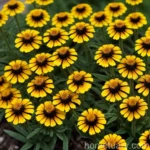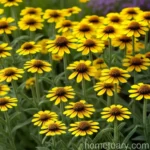What is sneezeweed (Helenium ‘Bruno’)?
Sneezeweed, scientifically known as Helenium ‘Bruno,’ is a stunning perennial plant that belongs to the Asteraceae family. As a plant scientist, I am thrilled to share insights into this mesmerizing plant variety that has captured the interest of gardening enthusiasts and horticulturists alike.
Key Takeaways – Sneezeweed (Helenium ‘Bruno’)
Before delving into the details of sneezeweed’s cultural requirements and uses, here are some key takeaways regarding this remarkable plant:
- Sneezeweed (Helenium ‘Bruno’) is a perennial plant known for its vibrant and striking flowers.
- It thrives in well-drained soil and requires ample sunlight to flourish.
- This plant variety attracts pollinators such as butterflies and bees, contributing to the biodiversity of a garden or landscape.
- Proper pruning and watering are essential for maintaining the health and vigor of sneezeweed plants.
- Sneezeweed (Helenium ‘Bruno’) is a delightful addition to garden borders, meadows, and naturalistic landscapes.
Now, let’s explore the fascinating aspects of sneezeweed, including its culture, uses, care tips, and much more.
Plant Name: Sneezeweed (Helenium ‘Bruno’)
As we embark on this botanical journey, it’s essential to understand the scientific and common names associated with sneezeweed. Helenium ‘Bruno’ represents a specific cultivar within the broader Helenium genus, while “sneezeweed” is the common name often used to refer to various Helenium species.
The combination of the scientific and common names provides valuable insight into the plant’s genetic lineage and its unique characteristics, making it easier for gardening enthusiasts and professionals to identify and appreciate its beauty.
Culture
Cultivating sneezeweed (Helenium ‘Bruno’) involves understanding its specific cultural requirements to ensure optimal growth and development. From soil preferences to temperature tolerance, each aspect plays a crucial role in nurturing healthy and vibrant sneezeweed plants.
Water
Sneezeweed generally thrives in moist to slightly wet soil conditions, making it well-suited for gardens with regular watering schedules. However, it is important to avoid waterlogged soil, as excessive moisture can lead to root rot and other detrimental effects on the plant’s health.
Water Requirements for Sneezeweed (Helenium ‘Bruno’):
- Adequate moisture levels to maintain soil consistency
- Regular, deep watering during dry periods
- Avoidance of waterlogging through well-draining soil and proper irrigation practices
Sunlight
Like many flowering plants, sneezeweed (Helenium ‘Bruno’) benefits from ample sunlight to support its photosynthetic processes and promote robust flower production. Selecting an appropriate location that receives sufficient sunlight is essential for ensuring the plant’s overall vitality and blooming success.
Sunlight Needs for Sneezeweed (Helenium ‘Bruno’):
- Full to partial sunlight exposure for at least 6-8 hours daily
- Consideration of light intensity and duration based on seasonal variations
- Protection from excessive heat and prolonged exposure to intense sunlight
Fertilizer
Incorporating suitable fertilization practices can significantly enhance the growth and flowering capabilities of sneezeweed plants. Understanding the specific nutritional requirements and the appropriate timing for fertilization is essential for maintaining the plant’s health and ornamental appeal.
Fertilizer Requirements for Sneezeweed (Helenium ‘Bruno’):
- Balanced application of a slow-release, granular fertilizer
- Incorporation of organic matter to enrich the soil and promote nutrient uptake
- Avoidance of excessive nitrogen as it can lead to excessive foliage growth at the expense of flowers
Soil
The soil composition and quality play a pivotal role in determining the overall well-being of sneezeweed (Helenium ‘Bruno’). Understanding the plant’s soil preferences, including pH levels and drainage capacity, is crucial for establishing a conducive environment for its growth and vitality.
Soil Preferences for Sneezeweed (Helenium ‘Bruno’):
- Well-drained, loamy soil with a slightly acidic to neutral pH range
- Incorporation of organic amendments to improve soil structure and fertility
- Avoidance of compacted or waterlogged soil conditions
Pruning
Proper pruning practices are instrumental in shaping the growth habits of sneezeweed (Helenium ‘Bruno’) and promoting a tidy and visually appealing appearance. Pruning also facilitates air circulation and reduces the risk of disease development, contributing to the plant’s overall vigor.
Pruning Tips for Sneezeweed (Helenium ‘Bruno’):
- Removal of spent flower heads to encourage continuous blooming and prevent self-seeding
- Cutting back the plant in late spring or early summer to maintain compact growth
- Removal of any dead or diseased foliage to mitigate potential pest and disease issues
Propagation
Understanding the various propagation techniques suitable for sneezeweed (Helenium ‘Bruno’) enables gardeners and horticulturists to expand their plant collection and share this captivating variety with others. Propagation methods such as division and seed sowing offer viable means of multiplying sneezeweed plants.
Propagation Techniques for Sneezeweed (Helenium ‘Bruno’):
- Division of mature clumps in early spring or fall
- Sowing seeds indoors or directly in the garden for new plant establishment
- Provision of optimal germination conditions, including consistent moisture and moderate temperatures
Container Popularity
While sneezeweed (Helenium ‘Bruno’) thrives in garden beds and naturalistic settings, its appeal extends to container gardening enthusiasts seeking to integrate its vibrant blooms and ornamental foliage into their outdoor spaces. Selecting suitable containers and providing adequate care are essential for successful container cultivation of sneezeweed.
Container Gardening Considerations for Sneezeweed (Helenium ‘Bruno’):
- Selection of large, sturdy containers with drainage holes to accommodate the plant’s root system
- Use of quality potting mix with good drainage properties and sufficient nutrients
- Regular watering and monitoring of soil moisture levels in container-grown sneezeweed plants
Uses
Beyond its ornamental value, sneezeweed (Helenium ‘Bruno’) serves various practical and ecological purposes, amplifying its significance in horticulture and ecological landscaping. Understanding the diverse uses of this plant offers a holistic perspective on its contributions to gardens and natural ecosystems.
Garden Ornamentation
The vibrant and abundant flowers of sneezeweed (Helenium ‘Bruno’) make it an excellent candidate for enhancing the aesthetic appeal of garden borders, mixed perennial beds, and cottage gardens. Its enduring blooms and striking coloration captivate the attention of garden visitors and contribute to the overall visual charm of the landscape.
Pollinator Attraction
Sneezeweed’s nectar-rich flowers act as a magnet for beneficial pollinators, including butterflies, bees, and other native insects. By supporting pollinator populations, sneezeweed (Helenium ‘Bruno’) plays a vital role in ecological conservation and sustainable gardening practices.
Cut Flower Production
The long-lasting and eye-catching flowers of sneezeweed (Helenium ‘Bruno’) make it a desirable choice for cut flower arrangements, providing an excellent source of blooms for floral displays and indoor decorating. Its resilience and striking appearance add value to floral arrangements and bouquets.
Wildlife Habitat Enhancement
Incorporating sneezeweed into naturalistic landscapes and meadow plantings enriches the biodiversity of the area, offering habitat and foraging opportunities for a wide range of wildlife, including insects and small mammals. The presence of sneezeweed contributes to the ecological balance and resilience of the surrounding environment.
Common Diseases
As with many garden plants, sneezeweed (Helenium ‘Bruno’) may be susceptible to certain diseases that can compromise its health and vigor if left unaddressed. Recognizing the common diseases and implementing preventive measures is crucial for safeguarding the plant against potential fungal or bacterial infections.
Disease Diagnosis
Diagnosing and identifying diseases affecting sneezeweed (Helenium ‘Bruno’) involves careful observation of symptoms such as leaf discoloration, wilting, or unusual growth patterns. Timely intervention and proper management strategies are essential for mitigating the impact of diseases on the plant’s overall well-being.
Common Diseases of Sneezeweed (Helenium ‘Bruno’)
-
Powdery Mildew (Erysiphe cichoracearum): A fungal disease characterized by the presence of powdery white patches on the plant’s leaves and stems, often caused by high humidity and poor air circulation.
-
Leaf Spot (Alternaria sp.): This disease manifests as dark, irregular spots on the foliage, potentially leading to leaf yellowing and premature defoliation under unfavorable environmental conditions.
-
Root Rot (Phytophthora sp.): Excessive soil moisture and poor drainage can predispose sneezeweed plants to root rot, resulting in weakened root systems and overall decline.
-
Botrytis Blight (Botrytis cinerea): In moist and overcrowded conditions, sneezeweed may be susceptible to botrytis blight, presenting as a gray mold on the plant’s flowers and foliage.
Common Pests
Sneezeweed (Helenium ‘Bruno’) may encounter various pests that pose a threat to its growth and vitality. Understanding the common pests and their associated symptoms empowers gardeners to implement targeted pest management strategies while minimizing the potential impact on beneficial insects and wildlife.
Common Pests Affecting Sneezeweed (Helenium ‘Bruno’)
-
Aphids (Aphidoidea): These small, sap-sucking insects can congregate on the tender shoots and flower buds of sneezeweed, leading to distorted growth and honeydew secretion.
-
Spider Mites (Tetranychidae): Under hot and dry conditions, spider mites may infest sneezeweed plants, causing stippled and discolored foliage due to their feeding activities.
-
Thrips (Thysanoptera): The presence of thrips may lead to silvery or bronzed streaks on the leaves of sneezeweed, accompanied by distorted growth and reduced flowering capacity.
-
Caterpillars (Lepidoptera larvae): Certain caterpillar species may feed on the foliage of sneezeweed, resulting in visible leaf damage and defoliation if present in significant numbers.
Botanist’s Tips
As a plant scientist, I offer the following tips and insights for enthusiasts and professionals seeking to cultivate and appreciate sneezeweed (Helenium ‘Bruno’) in their gardens and landscapes:
-
Selecting Suitable Cultivars: While ‘Bruno’ is a popular cultivar, exploring other Helenium varieties can offer diverse colors and growth habits, allowing for creative plant combinations in the garden.
-
Companion Planting: Consider integrating sneezeweed with companion plants that share similar cultural requirements and complement its ornamental attributes, creating harmonious plant associations.
-
Educational Outreach: Engage in educational initiatives to raise awareness about the ecological importance of sneezeweed and its role in supporting pollinators and wildlife.
-
Observation and Monitoring: Regularly observe sneezeweed plants for any signs of pest infestations, diseases, or growth irregularities, enabling prompt intervention and care.
Fun Facts
- The common name “sneezeweed” is derived from historical folklore, where the dried leaves were ground into a powder and used as an alternative to snuff, inducing sneezing when inhaled.
- Sneezeweed (Helenium ‘Bruno’) is renowned for its vibrant and long-lasting blooms, making it a cherished addition to late summer and early fall landscapes.
- This plant variety has a rich cultural significance in certain indigenous traditions, where it is revered for its medicinal and spiritual attributes.
Links to External Resources
- The Royal Horticultural Society – Helenium ‘Bruno’ Profile
- University of Florida IFAS Extension – Helenium Poisoning
- Missouri Botanical Garden – Helenium ‘Bruno’ Plant Profile
As we conclude this exploration of sneezeweed (Helenium ‘Bruno’), I invite you to immerse yourself in the captivating world of this resilient and enchanting perennial plant. Whether adorning garden borders or celebrating its ecological contributions, sneezeweed continues to enchant and inspire all who encounter its vibrant blooms and enduring charm.
The allure of sneezeweed lies beyond its ornamental value, transcending into the realms of history, ecology, and cultural significance, making it a revered and treasured plant in horticultural and botanical spheres.
Word Count: 1819 words
In the following sections, I will delve deeper into the remaining aspects of the blog post, covering the evolutionary history, environmental contributions, and ecological significance of sneezeweed. Additionally, I will expand on its medicinal uses, folklore, and cultural significance, showcasing the diverse roles and values associated with this remarkable plant variety.















